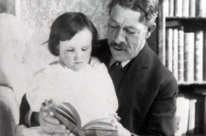
Those of you who watched Part 3 of the Ken Burns documentary Cancer: The Emperor of All Maladies last night might have been surprised to learn that the most promising breakthrough in cancer treatment today—immunotherapy—actually goes back more than 100 years, to a man named William Coley. Coley was a surgeon at Memorial Hospital who developed an approach to treating cancer that involved injecting patients with a mixture of heat-killed bacteria in the hopes of stimulating the body’s “resisting powers.”
Coley was inspired to pursue this approach after stumbling on the case of a patient whose cancer regressed after he came down with a severe skin infection. The documentary suggests that Coley’s approach was abandoned because other doctors could not replicate his results. But the story is a bit more complicated—and interesting—than that.
Coley’s approach was actually used by many doctors in the years around the turn of the century and after, including by the famous Mayo brothers (of the Mayo Clinic in Minnesota) and orthopedic surgeon Henry W. Meyerding. Meyerding used the toxins in conjunction with surgery for patients with bone cancer, achieving survival rates far higher than with surgery alone. Coley corresponded with many of the doctors who used the toxins and documented their results. (Coley never threw away any of these letters and they form the basis for a biography of Coley that the Cancer Research Institute will be publishing soon.)
If Coley’s method was sometimes successful, why then did it fall out of use? Two main factors account for this shift. First, Coley’s toxins were not easy to make or administer. Different formulations made by different laboratories had differing levels of potency. As well, Coley found that he needed to carefully tailor the injection schedule to each patient in order to induce and sustain a fever, which he believed was an important part of the mechanism of operation of the toxins. Few other physicians likely took the same careful and painstaking approach as he did.
Second, Coley’s toxins had the misfortune of being utilized right around the time that radiation therapy was coming into vogue. X-rays were discovered in 1895, and began to be used therapeutically to treat cancer by 1896. A few years later, the closely related Becquerel rays of radium were recognized as another effective form of radiation therapy. Unlike Coley’s toxins, radiation had clear and consistent results in nearly every patient.
Radiation also had the backing of powerful people at Memorial Hospital, including and especially James Ewing, who was director of the hospital and essentially Coley’s boss. Whereas Coley thought that radiation therapy was useful in some cases (and was in fact the first person to obtain X-ray machines for the hospital), Ewing believed that radiation therapy should form the backbone of treatment for essentially ever cancer patient. Ewing was encouraged in this view by a large financial gift from wealthy mining industrialist James Douglas, who was a strong advocate for radium. By the late 1920s, Memorial owned nearly 8 grams of radium (including the original batch produced by Marie Curie) and had become known as “radium hospital,” according to historian David Hess.
The advent of chemotherapy, in the 1940s, pushed Coley’s toxins further to the margins of medicine. Another powerful figure at Memorial, Cornelius Rhoads, was as passionate a spokesman for chemo as Ewing had been for radiation. The head of research for the Chemical Warfare Division during WWII, Rhoads took a predictably military approach to combating cancer. He oversaw a massive screening program at Sloan Kettering geared toward identifying a chemical compound that might serve as a magic bullet against cancer. Rhoads was dismissive of individuals who did not share his faith in chemotherapy. In 1955, he ordered the manufacturing of Coley’s toxins at Memorial stopped, even while patients were still being treated with the therapy.
 Coley’s toxins would likely have fallen completely into historical obscurity were it not for the efforts of his daughter, Helen Coley Nauts, to revive their reputation and use. In the years following her father’s death, she systematically tracked down case reports and long-term follow-up information on hundreds of patients treated with Coley’s toxins, by her father and other physicians around the world. In numerous articles and monographs, she presented abundant evidence that her father’s method had indeed worked in a significant number of patients. To help raise awareness of her findings, Nauts founded the Cancer Research Institute in 1953. Though it took many years, Nauts’s efforts to interest the mainstream medical establishment in her father’s method of cancer treatment were eventually successful.
Coley’s toxins would likely have fallen completely into historical obscurity were it not for the efforts of his daughter, Helen Coley Nauts, to revive their reputation and use. In the years following her father’s death, she systematically tracked down case reports and long-term follow-up information on hundreds of patients treated with Coley’s toxins, by her father and other physicians around the world. In numerous articles and monographs, she presented abundant evidence that her father’s method had indeed worked in a significant number of patients. To help raise awareness of her findings, Nauts founded the Cancer Research Institute in 1953. Though it took many years, Nauts’s efforts to interest the mainstream medical establishment in her father’s method of cancer treatment were eventually successful.
“Those who have scrutinized Coley’s results have little doubt that these bacterial toxins were highly effective in some cases,” wrote Lloyd J. Old, MD, who was associate director of Memorial Sloan Kettering, and also CRI’s medical director from 1971-2011.
Nowadays, it is fashionable to credit Coley with having started cancer immunotherapy, and with being “ahead of his time.” But that raises the obvious question: if today’s scientists agree that Coley’s toxins were effective at treating cancer, why aren’t they still being used?
“Unproven Methods”
Part of the answer to that question is logistics: in the wake of the thalidomide tragedy in Europe, in which women took a drug for morning sickness that turned out to cause birth defects, the FDA took a hard line on drug safety. In 1962, Congress passed the Kefauver-Harris amendment (aka the “Drug Efficacy Amendment”) to the Federal Food, Drug, and Cosmetic Act. This amendment introduced a requirement that drug manufacturers must provide proof of a drug’s safety and efficacy before it can be approved by the FDA. The amendment contained a clause that allowed long-used drugs such as aspirin to be grandfathered in. But in 1963 the FDA declared that Coley’s toxins were a “new drug” (despite having been used for more than 60 years) and could not be used in the U.S. without first going through rigorous clinical testing. To this day, anyone who wants to use the treatment must apply to the FDA for permission. This process is costly and time-consuming, and presents a major logistical hurdle to anyone wanting to study the toxins (though some studies have been conducted; see below).
Another major factor relates to the state of knowledge about immunology and cancer. Coley could not explain how his toxin therapy worked. An understanding of how the cells of the immune system fight cancer was still decades away. In the absence of this knowledge, it was easy for mainstream cancer researchers to dismiss Coley’s work as quackery. In 1965, the American Cancer Society added Coley’s toxins to its “Unproven Methods of Cancer Therapy.” This inclusion effectively marked Coley’s toxins as beyond the pale among mainstream cancer researchers. The ACS would eventually remove Coley’s Toxins from the list (10 years later) but by then the damage had been done.
It was not, of course, the intention of the ACS to squelch promising new research. Rather, they were interested in protecting patients from the claims of charlatans who promised to cure cancer with various homemade potions and unproved therapies. But unfortunately, that meant casting an extremely skeptical—and at times unfair—eye toward any therapy that did not fit within the dominant surgery-radiation-chemo paradigm.
Despite the significant logistical hurdles, a clinical trial of the toxins was initiated at Memorial Sloan Kettering in 1976, under the direction of Herbert Oettgen, MD, a longtime member of CRI’s Scientific Advisory Council. Patients with advanced non-Hodgkin lymphoma were randomized to receive or not receive injections of Coley’s toxins five days before each cycle of chemotherapy. The early results of the study seemed promising—the Coley’s toxins group had better survival than the control group—but the survival curves eventually merged and the study was stopped.
There have been a few other trials as well, but none has been conclusive one way or the other.
“The problem always has been that Coley’s toxins were made from bacteria,” recalled Oettgen in a 2013 interview. “We knew what bacteria they were, but even bacteria with the same name can vary widely. And so it was never certain that one Coley’s toxins is the same as another Coley’s toxins. And that has sort of plagued the whole field.”
Given the difficulties with pursuing research on the toxins, CRI under Lloyd Old’s leadership began in the 1970s to take a different tack: focusing on understanding the basic aspects of how the immune system functions, including how it recognizes cancer. Old had faith that eventually our knowledge of the immune system would progress to the point where we would be in a better position to understand the “Coley phenomenon,” including why it wasn’t more consistently effective. And he promised Helen Nauts that Coley’s toxins would get a fair trial one day.
Reconsidering Coley
The next few decades, beginning in the 1970s, would see an explosion of research into cancer immunology. Scientists made a number of important discoveries that deepened our understanding of how the immune system fights cancer. Cytokines, the chemical messengers of the immune system, were isolated in the 1970s and 80s. The first tumor-specific antigens were discovered in the early 1990s. By the late 1990s, the role of innate immunity, including the role of Toll-like receptors (TLRs) and pathogen-associated molecular patterns (PAMPs), in activating an immune response was deciphered. And by the mid-2000s, the importance of checkpoints—the immune system’s brakes—was beginning to be understood.
 At last, the time seemed right to revisit Coley’s toxins, with a deeper understanding of how the immune system functions. In 2007, CRI funded a phase I clinical trial of Coley’s toxins for patients with a variety of cancer types. The trial was conducted at Krankenhaus Nordwest hospital in Frankfurt, Germany, under the direction of Elke Jäger, MD, a member of CRI’s clinical trials network. Patients received subcutaneous injections of Coley’s toxins twice a week until fever was induced, and then for four additional doses.
At last, the time seemed right to revisit Coley’s toxins, with a deeper understanding of how the immune system functions. In 2007, CRI funded a phase I clinical trial of Coley’s toxins for patients with a variety of cancer types. The trial was conducted at Krankenhaus Nordwest hospital in Frankfurt, Germany, under the direction of Elke Jäger, MD, a member of CRI’s clinical trials network. Patients received subcutaneous injections of Coley’s toxins twice a week until fever was induced, and then for four additional doses.
Unlike previous clinical trials of the toxins, this one was conducted with toxins manufactured according to Good Clinical Practice (GCP) guidelines, with standardized bacterial components. The trial also incorporated laboratory measures of immune responses—blood levels of cytokines, for example—which were not previously possible, and targeted specifically patients whose cancers expressed the specific molecular flag called NY-ESO-1.
Like all phase I studies, the main objective of this study was not to determine clinical efficacy but rather to establish safety and determine optimal dosing. Nevertheless, there were some tantalizing findings. The toxins were effective at inducing fever and robust surges in cytokines. One patient with metastatic bladder cancer had a clear clinical response to treatment, experiencing a 50% reduction in his cancer that correlated with elevated levels of cytokines.
Given these intriguing results, Jäger says she and her colleagues are eager to do further testing of Coley’s toxins, but there are logistical hurdles that make that challenging. For one thing, the cost of preparing another batch of Coley’s toxins would run about $1.2 million. It costs so much to make the drug, she says, because of the complexities involved in manufacturing a bacteria-derived product according to GCP guidelines.
There are also difficulties getting approval to conduct studies of the toxins the way Coley used them. For Coley, fever was an important component of the therapy—the induction of fever was a sign that the toxin therapy was working. And he kept giving the toxins at increasing doses so that the fever was maintained. And this went on for weeks and sometimes months at a time.
Modern hospital institutional review boards (IRBs) will not permit such an approach. Even getting the German hospital to allow fever as a goal in this study was a challenge. “We had to work very hard to convince the authorities that fever is a study endpoint,” says Jäger.
A final hurdle—and perhaps the most pertinent one today—is the fact that cancer immunology has progressed so far in the past few years that other approaches have far eclipsed Coley’s toxins. Considering the current excitement being generated with checkpoint inhibitors and CAR T cell therapy, for example, no one is really interested in starting at the beginning again with Coley’s toxins.
In some ways, the question “Why aren’t Coley’s toxins still in use?” is the wrong one to ask. It obscures the extent to which many current immunotherapies are, in fact, direct descendants of Coley’s toxins. Take, for example, Toll-like receptors agonists, which are being tested alone and as adjuvants in cancer vaccines. Coley’s toxins are believed to have worked in part by binding to and stimulating TLRs on immune cells. But it was not until the 1990s that scientists discovered that TLRs even existed.
Coley himself found that the toxins were most effective when given after surgery as a way to prevent recurrence. This mirrors contemporary immunotherapy approaches that combine surgery with cancer vaccines.
Lloyd Old used to say that science hadn’t caught up with Coley, and that’s why more basic research was needed. We still aren’t totally there, but we are are closer and closer each day. Consider making a donation to the Cancer Research Institute today.
